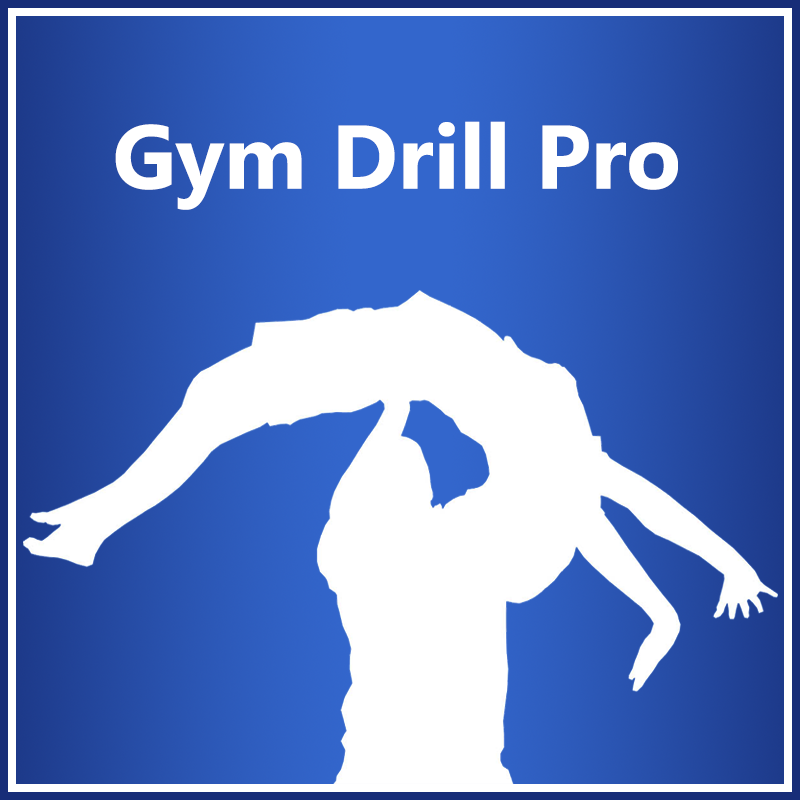

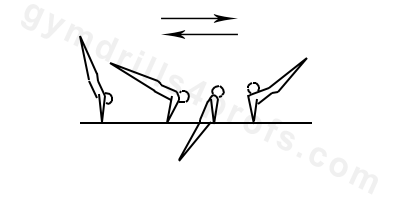
The swing on parallel bars is divided into front and back sections. During the forward portion of the swing, the gymnast should ensure that their body is not piked. As the body approaches the bottom of the swing the gymnast should maintain a slightly arched position from their chest. At this point the gymnast should kick their heels behind them, creating a slight arch in their body. Correct execution of the swing technique at the bottom generates a powerful forward and upward motion. As the gymnast’s swing gets higher and they begin to reach handstand, their body should become straight.
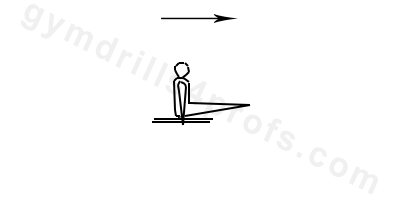
The L-sit is classified as difficulty “A” in the Code of Points. It also exists in almost any USAG compulsory level routine.This drill starts from a straight body position on the parallel bars. The gymnast’s hands should be placed on the bars at shoulder width. The gymnast should keep their arms tight and lift their legs to a horizontal position. The legs should be straight while the gymnast holds this position for two seconds. The hips should be between the arms (not behind). The head is slightly up.
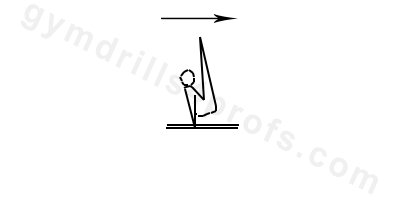
The V-sit on parallel bars is not a FIG CoP skill, but still exists as a bonus in the Level 5 routine and is the basis for a wide range of other gymnastics skills, such as v-sit on the floor, kip on parallel bars, Adler on high bar and etc. For the successful execution of the skill, the gymnast should acquire a minimum level of abdominal and leg strength. The skill starts from the support position. Tight legs should gradually raise forward until they are up to vertical. The arms are tight. This skill requires a 2-second hold. The head should be in a neutral position.
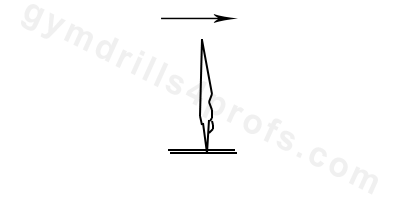
The handstand on parallel bars is an “A” difficulty skill. It’s a common connection skill in most optional routines. It also exists in the level 5 routine as a bonus. In order to perform the skill on the bars, the bar’s width should be fixed at the proper distance (usually at the width of the gymnast’s shoulders). A handstand involves holding a tight body position in an inverted vertical position, balancing on one’s hands. The most basic form of a handstand involves the arms and legs being completely straight. The feet should remain together. This makes balancing easier. During the handstand, the glutei and back should be tight, and the head should be in a neutral position, with the eyes watching the hands. It’s very important not to watch the hands with the head back, as this can lead to arching through the entire back. The shoulder angle should be completely straight, and the body should be stretched. As the handstand improves, more difficult modifications of the skill can be performed.
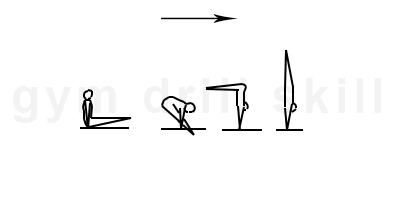
The skill starts in an L-sit. The body is in vertical, between the arms. The buttocks should not be behind the arms. The gymnast slowly raises their buttocks in a piked position until they extend the shoulder angle and the feet lift over the bars. At that moment the body and the arms should create one straight line vertically. After that, the legs open in straddle and raise until the gymnast reaches handstand. The arms and legs are straight.
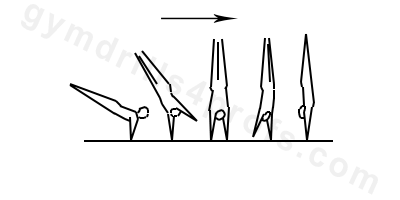
This skill starts with the backswing. In the upward phase the gymnast should initiate a quarter turn around the support arm, at the same time they should transfer their body onto the single rail. Their arms should be placed on the bar at roughly shoulder distance and width. The gymnast should already be in handstand by the time they get to the single rail. Their body should continue to be transferred onto the the post arm. This arm will become the support arm on which the gymnast finishes the skill by completed another quarter turn. They should finish the pirouette in handstand on both rails. There are two ways to do a pirouette. It can either be done through an initiation early in the swing, or from a handstand hold. The first method involves the athlete initiating the skill before reaching the handstand position. It’s critically important for the gymnast to be in an exact straight body position if this method is used. When they transfer their body from one hand to another, they should not break the straight line from their hips or any other part of the body.
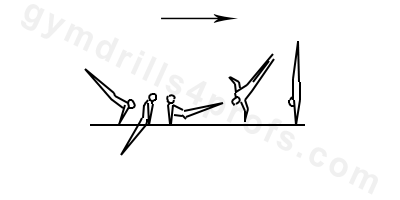
This skill starts with a handstand. From support, the gymnast begins to turn the hips in front of the bar. Around the horizontal position in the front swing, the body should be turned ¼ and the straight body should be supported on one arm. The leading arm pushes away from the bar in order to raise the body up to the one arm handstand. Before reaching the handstand, the arm blocks the bar and hops. During the release, the body turns another ¼ and finishes the skill on both bars in a handstand. The gymnast should emphasize on pushing away with one arm up to the handstand. This is the main move which helps the gymnast to finish the skill in a handstand.
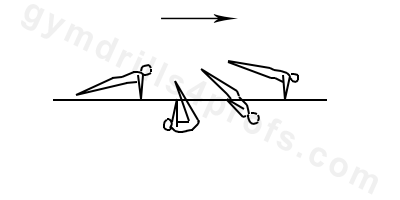
The Feldge / Peach / Basket can be performed with two modifications: freehip or stalder. The gymnast should perform a backward roll to candlestick or reversed pike. At this stage in the skill, it’s important that the hips are away from the gymnast’s hands. Simply said, it has to be a free hip, not a back hip circle. Keeping the hips far away helps the gymnast to obtain a wide circle, which will give them enough speed for the second part of the skill. If the hips are too close to the hands, the circle is cut short and as a consequence the skill will move slower. When the gymnast’s shoulders are at the lower part between the bars, the second part of the skill begins. The gymnast should gradually open the angle of the shoulders, push back on the rails, and open the body from pike to hollow. Pushing on the bars helps to stop the back flipping and transform it into a upwards momentum. This will raise the gymnast’s body to vertical. Opening the body from pike to vertical will help the gymnast accelerate the speed and send the direction up to handstand. The grip is inward and the gymnast should hold the rails for as long as possible. It helps to feel the support position and push on the bars. At the last moment of the skill, the gymnast should switch their hands and finish in a handstand position.
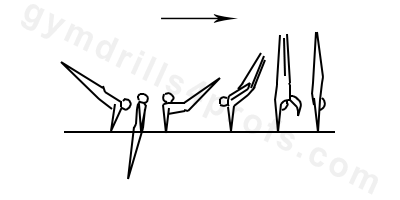
This skill starts with a handstand. From support, the gymnast begins to turn the hips in front of the bar. Around the horizontal position in the front swing, the body should be turned ¼ and the straight body should be supported on one arm. The leading arm pushes away from the bar in order to raise the body up to the one arm handstand. During the handstand, the body continues to turn around the holding arm until a complete full turn has been done. The skill finishes with both arms on the bar in a handstand. The gymnast should emphasize on pushing away with one arm up to the handstand. This is the main move which helps the gymnast to finish the skill in a handstand.
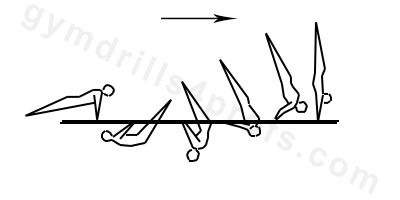
Peach/basket to handstand is a very high level technical skill. The gymnasts who are doing this skill should already have a significant amount of experience, strength, flexibility, and coordination. The gymnast should be knowledgeable and have a clear understanding of swings on the parallel bars. It is especially important that the gymnast is experienced with a piked swing under the bars. The skill can be done from handstand or front support. The gymnast should perform a backward roll to candlestick or reversed pike. At this stage in the skill, it’s important that the hips are away from the gymnast’s hands. Simply said, it has to be a free hip, not a back hip circle. Keeping the hips far away helps the gymnast to obtain a wide circle, which will give them enough speed for the second part of the skill. If the hips are too close to the hands, the circle is cut short and as a consequence the skill will move slower. When the gymnast’s shoulders are at the lower part between the bars, the second part of the skill begins. The gymnast should gradually open the angle of the shoulders, push back on the rails, and open the body from pike to hollow. Pushing on the bars helps to stop the back flipping and transform it into a upwards momentum. This will raise the gymnast’s body to vertical. Opening the body from pike to vertical will help the gymnast accelerate the speed and send the direction up to handstand. The grip is inward and the gymnast should hold the rails for as long as possible. It helps to feel the support position and push on the bars. At the last moment of the skill, the gymnast should switch their hands and finish in a handstand position.
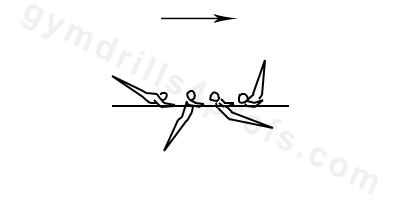
The gymnast should begin in upper arm support with their arms bent around 90 degrees. The front swing technique begins at the highest point in the back swing in a hollow body position. The body should arch slightly, and snap down through the bottom of the swing. On the way up to the highest point in the front swing, the gymnast should maintain a hollow body. From the top of the front swing, the back swing technique begins. The gymnast’s body should be extended until the very bottom of the swing. Next, the gymnast should kick with their heels and create a slightly arched body position.
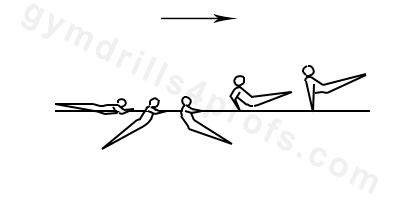
The gymnast should begin in support on the parallel bars. Next, they should perform a back swing and bend their arms in order to bail into the upper arm support position. The arms should be bent roughly 90 degrees. In the first phase of this skill the body should be straight. Following this is a front swing in the upper-arm position. The gymnast should perform a slight kick in the bottom. Their body should go from being slightly arched to slightly hollow. The kick is combined with pushing on the bars from the arms. In the last phase of the front swing the gymnast’s arms should be fully extended while the body is in a hollow position. The skill finishes in the rear support position ready for the backswing.
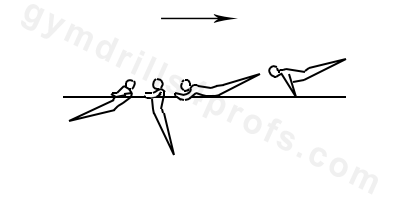
This skill starts in upper arm support during the backswing. At the highest point of the backswing, the gymnast pushes down the bars and tighten the arms. The heels kick strongly backward. The body is slightly arched. The skill finishes in front support with the body around the horizontal and above.
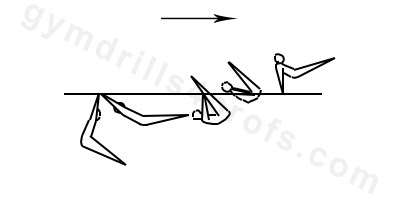
A kip is generally performed during the beginning or middle of a routine. The gymnast should start from a short run or from standing. They should bounce strongly on the springboard and jump between the rails high and forward. Once they grab the rails, they should swing so that their body reaches the horizontal position. This helps the gymnast accelerate to execute a glide swing in the front. The gymnast should fully extend their shoulders and keep their body in a slightly hollow position. Alternatively, they could pike their body enough to avoid touching the ground. At the end of the glide swing in the front, the gymnast should first pike with their hips, then their shoulders. During the suspension, their body should be fully compressed in a piked basket position. Ideally, the kip should be performed in a jam modification. This is to say that the skill should finish in a piked manna position on the rails. This helps the gymnast execute a strong and powerful back swing immediately after. The lesser modification is more similar to a kip on high bar. In the piked swing backward, the gymnast brings their body over the rails and at the same time they should open their hips. The skill should finish in a dynamic rear support. There are two main points that the gymnast should emphasize on. The glide swing should be strong and powerful. During the bottom of the piked back swing, the gymnast should start to push the rails backward.
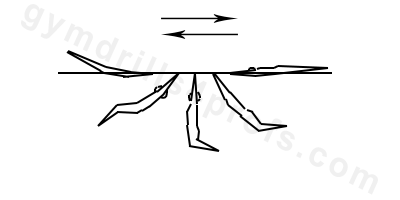
The long swing on parallel bars is similar to the swing on high bar. When the gymnast is younger and not too tall, the swings could be performed with tight legs. But in general, the swings are performed with bent knees.
The skill starts at the highest point of the backswing. The gymnast should be in a hollow body position with their head neutral. At the bottom of the swing, the gymnast should arch slightly, making a whip. The difference between the high bar and parallel bars swing is that the gymnast performs the final kick with the knees. After the tap, the gymnast’s body should continue in a hollow until the top of the swing. After this, follows the back swing. Until the bottom of the back swing the body should be exactly tight. After the suspension, the gymnast should begin to hollow and become slightly piked while they shift their wrists. This prevents them from slipping off while regrasping. The back swing finishes at the very top of the move in a hollow position.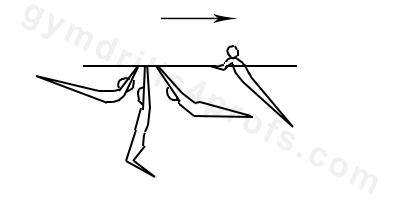
This skill begins with a back swing. From the highest point of the front swing, the gymnast swings down with an extended shoulder angle and bent legs. The younger gymnasts who are still not too tall can perform the swing with tight legs. At the lower position in the swing, the athlete performs a strong kick from the heels. The body becomes slightly arched. The highest point of the backswing should be at the level of the bars or above them. The gymnast opens the bent arms sideways and places them onto the bars. The gymnast should have a strong grip on the bar and avoid sliding backward as they perform this skill. The skill finishes in the highest point of the upper arm support back swing.
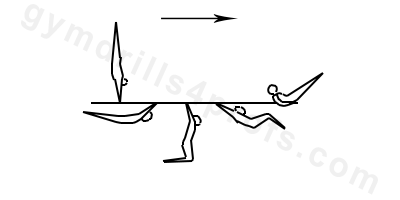
From a handstand, the gymnast should start the skill by bailing down to the bottom of the swing under the bar. There are two modifications. The first one is to bail with an extended tight body until the bottom of the swing. The second modification is one in which the gymnast begins to arch their body from their shoulders when they are at the level of the rails. In the second case, it’s easier to perform the skill, because the acceleration and speed is relatively moderate, and the subsequent push off the rails is not as strong. The problem however, is that the gymnast can potentially develop an incorrect habit of “brushing” for the giant swings too. At the level of the rails, the gymnast should start to bend their legs from their knees and pass through the bottom with their shoulders and hips extended. Their legs should be bent with their head in the middle position. During the upswing the gymnast should push back strongly on the bars and begin to tighten their legs. Pushing the rails stops the rotation, at this point the gymnast should raise their body above the rails and finish in front upper arm support.
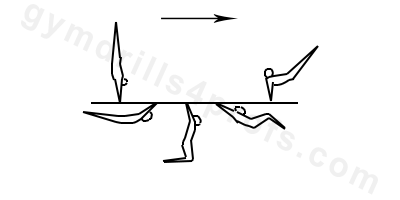
From a handstand, the gymnast should start the skill by bailing down to the bottom of the swing under the bar. There are two modifications. The first one is to bail with an extended tight body until the bottom of the swing. The second modification is one in which the gymnast begins to arch their body from their shoulders when they are at the level of the rails. In the second case, it’s easier to perform the skill, because the acceleration and speed is relatively moderate, and the subsequent push off the rails is not as strong. The problem however, is that the gymnast can potentially develop an incorrect habit of “brushing” for the giant swings too. At the level of the rails, the gymnast should start to bend their legs from their knees and pass through the bottom with their shoulders and hips extended. Their legs should be bent with their head in the middle position. During the upswing the gymnast should push back strongly on the bars and begin to tighten their legs. Pushing the rails stops the rotation, at this point the gymnast should raise their body above the rails and finish in the rear support position with their arms and legs tight.
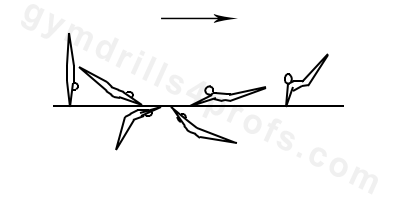
From a handstand the gymnast should start the skill by bailing down to the bottom of the swing. There are two modifications. The first one is to bail with an extended tight body, and around the level of the rails the gymnast should pike their body from the hips with tight legs. This helps to increase the speed, but after that the gymnast should conclude the reverse hecht move much faster. In the front swing, they should also push back on the rails much stronger. The second modification of the move starts with a tight arch bail, it compresses the body for the following whip and pike. In this case it’s easier to perform the skill because the acceleration is relatively moderate. This means that the subsequent push off the rails is not as strong. A potential problem with this method is that the gymnast can develop the wrong habit of “brushing” for the giant swings. At the very bottom of the swing, the gymnast should be in a piked position without touching the ground. They should have extended shoulders with their head in the middle position. Next, the gymnast should open their hips and kick them upward in the final move of the reverse hecht swing. Their arms should push back strongly on the rails. This helps to reverse the swing and to raise the athlete onto the bars in a low rear support position. The stronger the gymnast pushes on the rails, the lower the rear support is.
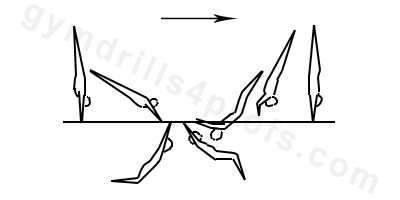
The giant swing to handstand begins from a handstand. The gymnast should perform a bail with a fully extended body, tight legs, and with no shoulder angle. This helps the gymnast enlarge the circle during the first part of the giant, which adds more acceleration. Taller gymnasts may bend their legs from the horizontal and after. The gymnast should pass through the bottom with a completely extended body, with bent legs from the knees, and their head in the middle position. After passing through the bottom, the athlete should cut the circle of the giant, transforming the body into a hollow tucked position. They should kick with tight legs (or knees if the legs are bent), and slightly close the angle of the body from their hips. In this position the body should begin to rise above the bars, circling around the hands. Starting in the bottom there should begin a very strong push back on the bars from the arms. This helps the gymnast to accelerate the move upward. Holding is provided as long as the gymnast can hold the rails inward. At the last possible moment, the gymnast should regrasp their hands. This is done through a blocking action with a hop. The gymnast then finishes the giant in a handstand. Taller gymnasts should gradually tighten their legs to handstand after the lower vertical. There are several important points that the coach should emphasize - “long” first half circle, holding the rails as long as possible, and pushing the bars back with the arms during the second half of the giant.
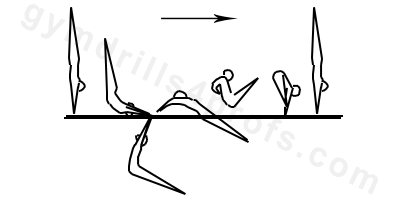
From a handstand, the gymnast should start the skill with a tight arch bail. Their shoulders should be extended with the body arched from the hips. Once the gymnast gets to roughly bar level, they should kick their legs forward into a pike position and pass through the lower point of the swing. They should keep the pike position to avoid touching the ground. Their shoulders should be open during this phase, with their head in the middle position. Next, the gymnast should open their hips and kick them upward for the final move of the reverse hecht swing. From their arms they should push back strongly on the rails. This will help them to reverse the swing and release upward. Once the gymnast is above the bars, they should open their legs and straddle, grabbing the bars in front of their legs. Following this skill is a press handstand in motion. The skill finishes in handstand.
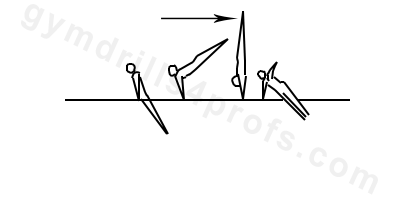
This skill starts in the backswing up to a momentary hold in the handstand. During the handstand, the gymnast should transfer their body and place one hand onto the other bar. They should release with their second hand and dismount over the bar. The body should be extended without any shoulder angle. The gymnast should emphasize on transferring the body in handstand onto one of the bars.
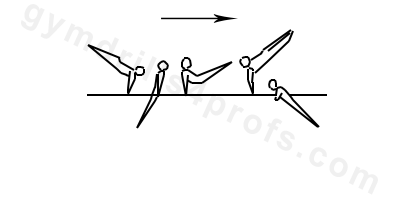
In the front swing, the gymnast turns their hips in front of the base bar and directs their feet over it. The swing should be in a diagonal over the dismounting bar. At the same time, the body should transfer onto the single bar as well. When the body reaches over the bar, the gymnast should remain on one arm laterally. At the highest point of the front swing (which should be over the horizontal), the body should be over the single bar, on one arm. The twisting motion over the holding arm continues with another half turn before landing. By the landing, the gymnast should have completed a half turn.
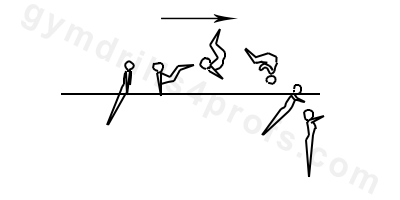
The back tuck-open salto dismount begins as does any other forward support swing. In this case, the swing begins in the handstand. The bars are loaded by the force of the downswing. As the swing passes through the bottom, the hips should open and the legs should trail slightly as the chest leads through the vertical bottom position. Remaining open through the bottom of the swing will enable a strong forward kick and lift as the body swings through the extended front swing position above horizontal. From here, the body swings upward and the radius of rotation is shortened through bending the knees. The body continues to swing upward and accelerates due to the shortening of the radius by the tucking action. The release of the bars should be triggered by the response of the bars bending. Optimally, this will coincide with the shoulders reaching maximum extension, providing a distinct lift or rise from the bars upon release. The body should extend from the tuck to full stretch at or before horizontal in preparation for the landing.
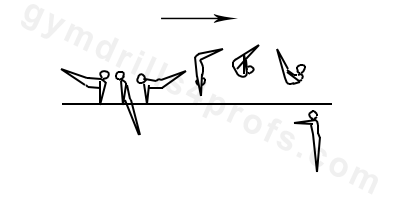
This skill starts with a strong back swing up to the handstand. Simultaneously, the gymnast should transfer their body over either bar and around the handstand position they should block and flip over the bar. At the moment of the block, the body should be slightly arched, with an open head and a very strong kickback from the feet. From the vertical position, the hands remain and the body rises, creating a V-position. Then the legs continue the rotation prior to the landing. The most important parts of the skill are the blocking actions against the bars during the handstand and a strong kickback from the feet. These two concepts will give height to the flip, and if the flip starts at the vertical position, the gymnast only needs to perform one half of a rotation in order to complete the skill.
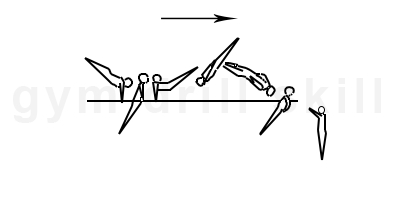
The back layout with a half turn dismount begins as does any other forward support swing. In this case, the swing begins in the handstand. As the swing passes through the bottom, the hips should open and the legs should trail slightly as the chest leads through the vertical bottom position. Remaining open through the bottom of the swing will enable a strong forward kick and lift as the body swings through the extended front swing position above horizontal. From here, the body swings upward and the radius of rotation is shortened through bending the knees. The body continues to swing upward and accelerates due to the shortening of the radius by the tucking action. The release of the bars should be triggered by the response of the bars bending. Optimally, this will coincide with the shoulders reaching maximum extension, providing a distinct lift or rise from the bars upon release. The body should extend from the tuck to full stretch at or before horizontal in preparation for the landing.
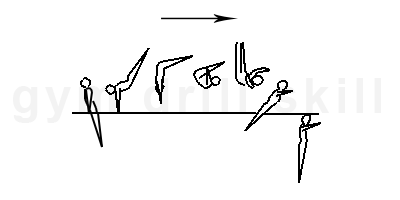
This skill starts with a strong back swing up to the handstand. Simultaneously, the gymnast should transfer their body over either bar and around the handstand position they should block and flip over the bar. At the moment of the block, the body should be slightly arched, with an open head and a very strong kickback from the feet. From the vertical position, the hands remain and the body rises, creating a V-position. Then the legs continue the rotation prior to the landing and simultaneously the body turns to complete one half of a twist. The most important parts of the skill are the blocking actions against the bars during the handstand and a strong kickback from the feet. These two concepts will give height to the flip, and if the flip starts at the vertical position, the gymnast only needs to perform one half of a rotation in order to complete the skill. It’s also very important that the gymnast performs the half twist in the last phase of the flip prior to landing.
Integral part of gymnastics coaching process are skill drills. They help gymnasts to learn easier and technically correct. With GYM DRILL PRO you will find variety of ideas for the most the basic gymnastics skills. There are plenty of images with skill drill progressions. It is intended to support explicitly the qualified coaches in their daily coaching business. DO NOT practice without the guidance of proper professionals.